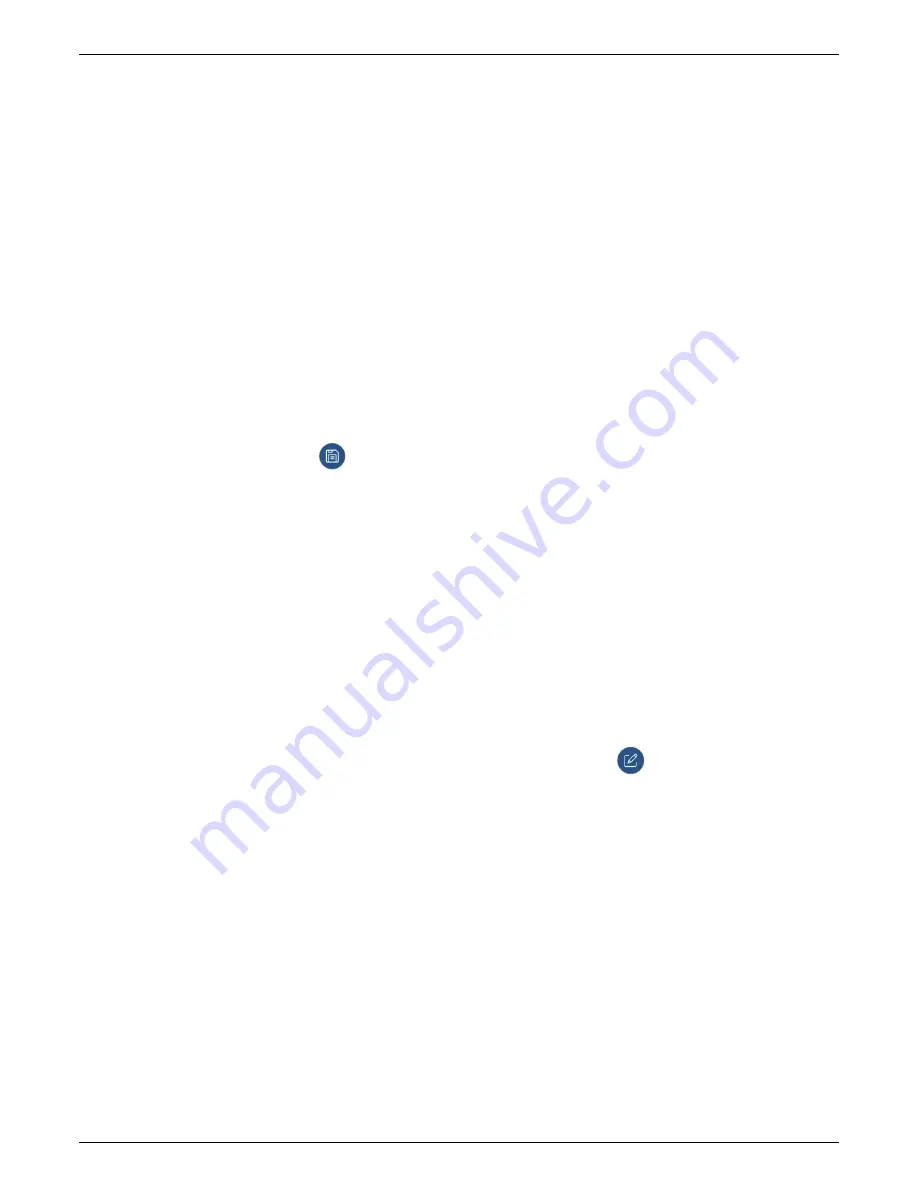
HOBO
MX
CO
2
Data
Logger
(MX1102A)
Manual
1
‐
800
‐
LOGGERS
9
www.onsetcomp.com
In
HOBOware:
From
the
Device
menu,
select
Launch.
2.
Set
the
Logging
Mode
to
burst
logging.
(If
already
selected
in
HOBOware,
click
the
Edit
button.)
3.
Select
the
sensor
that
will
have
burst
limits
in
HOBOmobile
and
HOBOware.
4.
Enable
High
Limit
if
you
want
burst
logging
to
occur
when
the
sensor
reading
rises
above
a
specific
reading.
Drag
the
slider
to
the
reading
that
will
trigger
burst
logging
or
type
a
specific
reading.
5.
Enable
Low
Limit
if
you
want
burst
logging
to
occur
when
the
sensor
reading
falls
below
a
specific
reading.
Drag
the
slider
to
the
reading
that
will
trigger
burst
logging
or
type
a
specific
reading.
6.
Set
the
burst
logging
interval.
Select
an
interval
faster
than
the
logging
interval.
Keep
in
mind
that
the
more
frequent
the
burst
logging
rate,
the
greater
the
impact
on
battery
life
and
the
shorter
the
logging
duration.
In
HOBOmobile,
tap
Done.
7.
Repeat
steps
3–5
for
any
other
sensors
if
desired
(tap
Done
or
Save
in
the
app
first).
8.
In
the
app:
Tap
Start
in
HOBOmobile
or
in
HOBOconnect.
In
HOBOware:
Click
OK
in
the
Burst
Logging
window
and
then
click
Start
in
the
Launch
Logger
window
when
ready.
Notes
about
Burst
Logging:
Sensor
alarms,
statistics,
and
the
Stop
Logging
option
“Never
(Wrapping)”
are
not
available
in
burst
logging
mode.
Once
the
logger
is
configured,
the
high
and
low
burst
limits
are
checked
every
15
seconds.
Therefore,
if
you
set
the
logging
interval
to
less
than
15
seconds
and
the
sensor
reading
falls
outside
the
levels,
the
burst
logging
will
not
begin
until
the
next
15
‐
second
cycle.
If
high
and/or
low
limits
have
been
configured
for
more
than
one
sensor,
then
burst
logging
will
begin
when
any
high
or
low
condition
goes
out
of
range.
Burst
logging
will
not
end
until
all
conditions
on
all
sensors
are
back
within
normal
range.
The
actual
values
for
the
burst
logging
limits
are
set
to
the
closest
value
supported
by
the
logger.
Burst
logging
mode
can
begin
or
end
when
the
sensor
reading
is
within
the
resolution
specifications.
Once
the
high
or
low
condition
clears,
the
logging
interval
time
will
be
calculated
using
the
last
recorded
data
point
in
burst
logging
mode,
not
the
last
data
point
recorded
in
“normal
mode.”
For
example,
a
logger
has
a
10
‐
minute
logging
interval
and
logged
a
data
point
at
9:05.
Then,
the
high
limit
was
surpassed
and
burst
logging
began
at
9:06.
Burst
logging
then
continued
until
9:12
when
the
sensor
reading
fell
back
below
the
high
limit.
Now
back
in
normal
mode,
the
next
logging
interval
will
be
10
minutes
from
the
last
burst
logging
point,
or
9:22
in
this
case.
If
burst
logging
had
not
occurred,
the
next
data
point
would
have
been
at
9:15.
A
New
Interval
event
is
created
each
time
the
logger
enters
or
exits
burst
logging
mode.
See
Logger
Events
for
details
on
plotting
and
viewing
the
event.
In
addition,
if
the
logger
is
stopped
with
a
button
push
while
in
burst
logging
mode,
then
a
New
Interval
event
is
automatically
logged
and
the
burst
condition
is
cleared,
even
if
the
actual
high
or
low
condition
has
not
cleared.
Statistics
Logging
During
fixed
logging,
the
logger
records
data
for
enabled
sensors
and/or
selected
statistics
at
the
logging
interval
selected.
Statistics
are
calculated
at
a
sampling
rate
you
specify
with
the
results
for
the
sampling
period
recorded
at
each
logging
interval.
The
following
statistics
can
be
logged
for
each
sensor:
The
maximum,
or
highest,
sampled
value,
The
minimum,
or
lowest,
sampled
value,
An
average
of
all
sampled
values,
and
The
standard
deviation
from
the
average
for
all
sampled
values.
For
example,
a
logger
is
configured
with
the
temperature
and
CO
2
sensors
enabled
and
the
logging
interval
set
to
5
minutes.
The
current
reading
and
all
four
statistics
are
enabled.
The
statistics
sampling
interval
is
set
to
30
seconds.
Once
logging
begins,
the
logger
will
measure
and
record
the
actual
temperature
and
CO
2
sensor
values
every
5
minutes.
In
addition,
the
logger
will
take
a
temperature
and
CO
2
sample
every
30
seconds
and
temporarily
store
them
in
memory.
The
logger
will
then
calculate
the
maximum,
minimum,
average,
and
standard
deviation
using
the
samples
gathered
over
the
previous
5
‐
minute
period
and
log
the
resulting
values.
When
reading
out
the
logger,
this
would
result
in
the
following
10
data
series
(not
including
any
derived
series):
two
sensor
series
(with
temperature
and
CO
2
current
readings
logged
every
5
minutes)
plus
eight
maximum,
minimum,
average,
and
standard
deviation
series
(four
for
temperature
and
four
for
CO
2
with
values
calculated
and
logged
every
5
minutes
based
on
the
30
‐
second
sampling
rate).
To
set
up
statistics:
1.
In
HOBOmobile:
Connect
to
the
logger
and
tap
Configure
in
HOBOmobile
or
tap
in
HOBOconnect.
In
HOBOware:
From
the
Device
menu,
select
Launch.
2.
In
the
app:
Tap
Logging
Mode
and
then
select
Fixed
Interval
Logging
in
HOBOmobile
or
Fixed
Logging
in
HOBOconnect.
In
HOBOware:
Select
Statistics
for
the
logging
mode.
3.
Select
Normal
in
the
app
or
Current
Reading
in
HOBOware
to
record
the
current
reading
for
each
enabled
sensor
at
the
logging
interval
selected.
Do
not
select
this
if
you
only
want
to
log
statistics.
4.
Select
the
statistics
you
want
the
logger
to
record
at
each
logging
interval:
Maximum,
Minimum,
Average,
and
Standard
Deviation
(average
is
automatically
enabled
when
selecting
Standard
Deviation).
Statistics
will
be
logged
for
all
enabled
sensors.
In
addition,
the
more
statistics
you
record,
the
shorter
the
logger
duration
and
the
more
memory
is
required.
5.
Set
the
statistics
sampling
interval.
The
rate
selected
must
be
less
than,
and
a
factor
of,
the
logging
interval.
For
example,
if
the
logging
interval
is
1
minute
and
you
select
5
seconds
for
the
sampling
rate,
then
the
logger
will
take
12












